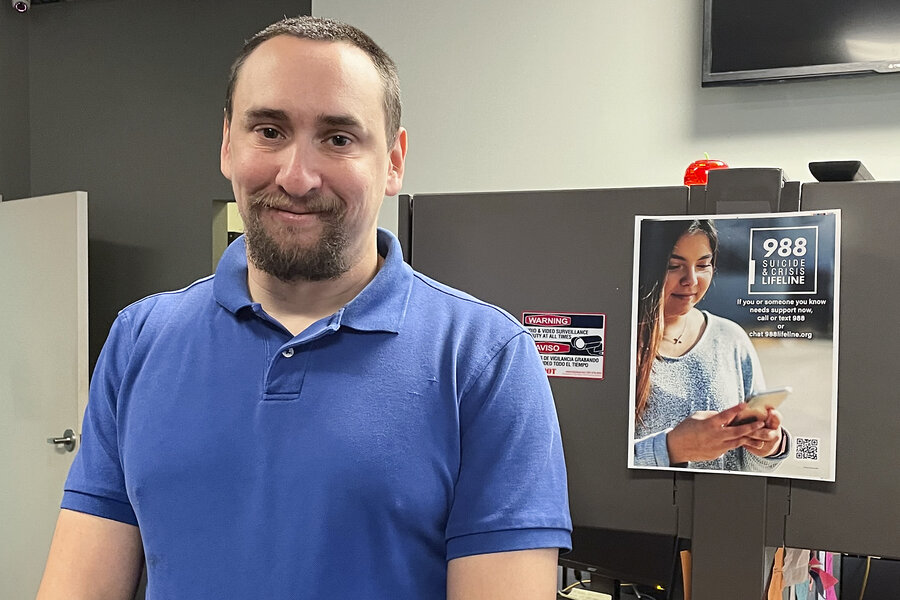‘More crucial than ever’: Mental health call centers reach new groups
Loading...
| Hyattsville, Md.
When Jamieson Brill answers a crisis call from a Spanish speaker on the newly launched national 988 mental health helpline, he rarely mentions the word suicide, or “suicidio.”
Mr. Brill, whose family hails from Puerto Rico, knows that just discussing the term in some Spanish-speaking cultures is so frowned upon that many callers are too scared to even admit that they’re calling for themselves.
“However strong stigma around mental health concerns is in English-speaking cultures, in Spanish-speaking cultures it is triple that,” said Mr. Brill, who helps people navigate mental health crises from a tiny brick building tucked away in Hyattsville, Maryland.
Mr. Brill works in one of more than 200 call centers fanned out around the country tasked with answering an uptick in calls day and night from people considering suicide or experiencing a mental health emergency.
With bipartisan congressional support and just under $1 billion in federal funds, the 988 mental health helpline has quickly expanded its reach in the six months since it launched – with over 2 million calls, texts, and chat messages pouring in.
The number of centers answering calls in Spanish grew from three to seven last year. A pilot line dedicated to LGBTQ youth started taking calls in September. And plans are underway to keep the momentum going, with the federal government adding Spanish language chat and text options later this year and aiming to expand those services to a 24/7 operation for the LGBTQ line.
When the around-the-clock phone launched last summer, it built on the existing network that staffed the old national lifeline, 1-800-273-8255. The new 988 number is designed to be as easy to remember as 911.
“The call volume is, in some instances, well beyond what we anticipated,” said Miriam Delphin-Rittmon, assistant secretary for mental health and substance use in the Department of Health and Human Services. “It does let us know that people are struggling, people are having a hard time. Where I feel heartened is that people are getting connected to services and supports, as [opposed] to struggling on their own.”
The 988 helpline registered 154,585 more calls, texts, and chat messages during November 2022 compared to the old national lifeline in November 2021, according to the latest data available.
Texting has been particularly popular, with the Substance Abuse and Mental Health Services Administration noting a 1,227% increase in texts to the line during that same time.
The Veterans Crisis Line – callers can press “1” after texting or calling 988 to reach it – has fielded 450,000 calls, texts, and chat messages, according to the Department of Veterans Affairs. By the end of the year, the line had handled a nearly 10% increase compared to 2021.
Calls show no signs of slowing into this year, with counselors answering 3,869 calls on New Year’s Eve and the first day of 2023 – a 30% increase compared to the previous holiday. The Spanish language line saw an increase of 3,800 calls year over year from November 2021 to November 2022.
Meanwhile, some states are considering unveiling their own lines dedicated to certain communities.
In November, Washington became the first state to launch a mental health crisis line dedicated to American Indian and Alaska Native people. Callers in Washington can reach the line by calling 988 then pressing “4” to be greeted by one of the 13 counselors – all Indigenous people – who staff the phones.
Having fellow American Indians answer those calls is crucial, because those familiar with the culture can immediately decode some terms that others cannot, said Rochelle Williams, the tribal operations manager for Volunteers of America Western Washington, which oversees the call center. For example, she said, when a caller says that a relative is “bothering me,” that sends up an immediate red flag: The person is likely signaling that they’re the victim of a sexual assault.
“Who has a better understanding of native people than native people?” Ms. Williams said. “We don’t trust in a lot of government programs. Knowing you’re talking to another Indigenous person is really important.”
Ms. Williams wants to add chat and text options next. She hopes Washington’s 988 line for Native Americans becomes a model for others. She’s already given presentations in New Mexico, Oklahoma, Montana, and in Canada, which is set to launch its own national 988 this year.
States are expected to receive more money to fund the line from the $1.7 trillion end-of-the year spending package, which set aside another half-billion dollars for the project.
Still, long-term funding for the 988 helpline is in jeopardy in some states, which have yet to figure out a permanent funding plan for it. While the federal government has poured millions of dollars into the project, states are expected to take over the operation and funding of the 988 line – just as they do with 911 emergency call services.
So far, fewer than 20 states have passed legislation to permanently fund their 988 line, according to the National Alliance on Mental Health Illness.
In Ohio, for example, advocates are pushing for the state legislature to sign off on a 50-cent fee that would be tacked onto cellphone bills, raising roughly $50 million to $55 million every year to operate the line, said Tony Coder of the Ohio Suicide Prevention Foundation.
“Quite frankly, lives depend on it,” Mr. Coder said. “The need for 988 services is more crucial than ever.”
This story was reported by The Associated Press.





